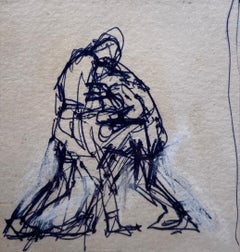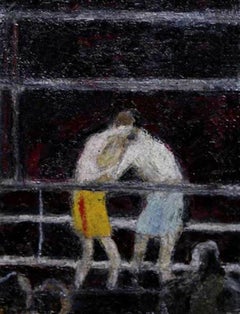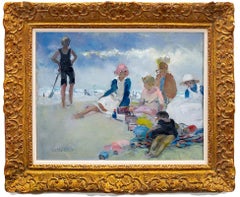Samuel Rabin Art
to
2
1
2
2
Overall Height
to
Overall Width
to
2
2
2
1
1
1
2
2
6,958
3,331
2,514
1,213
1
1
1
1
1
Artist: Samuel Rabin
Infighting, Ink Sketch, 20th Century British Artist, Framed
By Samuel Rabin
Located in London, GB
Ink on lined paper
Image size: 3 x 2 3/4 inches (8 x 7 cm)
Hand made frame
Sam Rabin
Samuel (Sam) Rabin, originally Samuel Rabinovitch, was an English sculptor, artist, teacher, singer, wrestler and Olympic bronze medallist. Rabin, who was Jewish, was born Samuel Rabinovitch on 20 June 1903 at Dewhurst Street, Cheetham, North Manchester. His parents were both Russian Jewish exiles from Vitebsk (now in Belarus).
During his childhood, the family moved to Salford where Rabin grew up and where his parents encouraged his talent for drawing. In 1914 Rabin won a scholarship to the Manchester Municipal School of Art making him, at the age of 11, the youngest pupil ever to attend the college. There he was taught drawing by French artist Adolphe Valette. In 1921 he moved to the Slade School of Fine Art in London where he continued his studies under Henry Tonks until 1924. After the Slade, Rabin studied in Paris where he met and was greatly impressed and influenced by sculptor Charles Despiau.
Rabin's own sculpture from this time is little known as he was a perfectionist and destroyed work that he considered unsatisfactory. In 1928, working under his full surname, he was commissioned by architect Charles Holden to carve West Wind, one of eight personifications of the four winds for the headquarters of the Underground Electric Railways Company of London at 55 Broadway. The sculpture was partly completed in-situ on the building. In 1930, he produced his only other public sculptures; two decorative winged masks, The Past and The Future, for the Daily Telegraph building in Fleet Street. These were carved on the building directly from the scaffold.
Both commissions were well received at the time, but Rabin was unable to make a living as a sculptor and turned to another career – wrestling, for which he abbreviated his surname. Rabin was physically strong and had boxed and wrestled as an amateur to fund his art. He won a bronze medal in the middleweight division of the free-style wrestling at the 1928 Olympics in Amsterdam. Rabin turned professional in 1932 and fought as Rabin the Cat and Sam Radnor the Heb. Alexander Korda cast him as a wrestler in The Private Life of Henry VIII in 1933 and as Mendoza, a Jewish prize-fighter, in The Scarlet Pimpernel in 1934. Despite lacking any formal musical training, Rabin was a talented baritone and worked professionally during the 1940s singing with Stars in Battledress and sang operatic arias with the army's Classical Music Group. In 1946 he auditioned for La Scala's conductor, Victor de Sabata.
In 1949, Rabin began teaching drawing at Goldsmith's College of Art in New Cross, London. His disciplined teaching style including the production of demonstration works, followed that of his own teacher, Valette. His students included Mary Quant, Bridget Riley and Tom Keating...
Category
Mid-20th Century Samuel Rabin Art
Materials
Paper, Ink
The Clinch, 20th Century Boxing Artwork, Mixed Media
By Samuel Rabin
Located in London, GB
SAMUEL RABIN
1903 - 1991
The Clinch
Oil on board
Image size: 7 x 5 ¾ inches
Hand made frame
Samuel (Sam) Rabin, originally Samuel Rabinovitch was an English sculptor, artist, teacher, singer, wrestler and Olympic bronze medalist.
Rabin, who was Jewish, was born Samuel Rabinovitch on 20 June 1903 at Dewhurst Street, Cheetham, North Manchester. His parents were both Russian Jewish exiles from Vitebsk (now in Belarus).
During his childhood, the family moved to Salford where Rabin grew up and where his parents encouraged his talent for drawing. In 1914 Rabin won a scholarship to the Manchester Municipal School of Art making him, at the age of 11, the youngest pupil ever to attend the college. There he was taught drawing by French artist Adolphe Valette.
In 1921 he moved to the Slade School of Fine Art in London where he continued his studies under Henry Tonks until 1924.
After the Slade, Rabin studied in Paris where he met and was greatly impressed and influenced by sculptor Charles Despiau.
Rabin's own sculpture from this time is little known as he was a perfectionist and destroyed work that he considered unsatisfactory. In 1928, working under his full surname, he was commissioned by architect Charles Holden to carve West Wind, one of eight personifications of the four winds for the headquarters of the Underground Electric Railways Company of London at 55 Broadway.
The sculpture was partly completed in-situ on the building. In 1930, he produced his only other public sculptures; two decorative winged masks, The Past and The Future, for the Daily Telegraph building in Fleet Street. These were carved on the building directly from the scaffold.
Both commissions were well received at the time, but Rabin was unable to make a living as a sculptor and turned to another career – wrestling, for which he abbreviated his surname.
Rabin was physically strong and had boxed and wrestled as an amateur to fund his art. He won a bronze medal in the middleweight division of the free-style wrestling at the 1928 Olympics in Amsterdam.
Rabin turned professional in 1932 and fought as Rabin the Cat and Sam Radnor the Hebrew Jew across Britain. Alexander Korda cast him as a wrestler in The Private Life of Henry VIII in 1933 and as Mendoza, a Jewish prize-fighter, in The Scarlet Pimpernel...
Category
20th Century Samuel Rabin Art
Materials
Oil, Board
Related Items
Belisama
By Oswaldo Vigas
Located in Palm Beach, FL
Predominantly recognized as a self-taught painter, he also worked in architectural murals, sculptures, ceramics, prints and drawings.
Vigas is one...
Category
1960s Cubist Samuel Rabin Art
Materials
Canvas, Oil, Gouache, Board
"A Day on the Beach"
By Martha Walter
Located in Lambertville, NJ
Jim's of Lambertville Fine Art Gallery is proud to present this piece by Martha Walter (1875-1976).
Born in Philadelphia in 1875, Martha Walter attended Girls’ High School followed ...
Category
1810s Samuel Rabin Art
Materials
Board, Oil
"Under the Large Striped Umbrella on a Foggy Day"
By Martha Walter
Located in Lambertville, NJ
Jim’s of Lambertville Fine Art Gallery is proud to offer this piece by Martha Walter (1875 - 1976).
Born in Philadelphia in 1875, Martha Walter attended Girls’ High School followed by the Pennsylvania Academy of the Fine Arts. It was at the Academy that Walter’s artistic talent was discovered. An admiring instructor by the name of William Merritt Chase took young Martha under his wing, giving her both inspiration and direction. She additionally enrolled with Chase at his summer school in Shinnecock, Long Island and in 1903, was awarded the Cresson Traveling Scholarship by the Pennsylvania Academy. This sent Martha Walter on travels to France, Italy, Spain, and Holland, where she attended the Grand Chaumiere and the Academie Julian in Paris. Afterwards, she established a studio on the Rue De Bagneaux in France with several other American women artists...
Category
1910s American Impressionist Samuel Rabin Art
Materials
Board, Oil
"Autumn Afternoon in Luxembourg Garden"
By Martha Walter
Located in Lambertville, NJ
Jim’s of Lambertville is proud to offer this artwork by:
Martha Walter (1875-1976)
Born in Philadelphia in 1875, Martha Walter attended Girls’ High School followed by the Pennsylva...
Category
Early 20th Century American Impressionist Samuel Rabin Art
Materials
Oil, Board
Man Reaching Down: Tondo
By Michael Leonard
Located in London, GB
Alkyd-oil on Masonite, signed and dated (middle left), 61cm (diam.), (83cm diam. framed). (This work was kept by the artist for his personal collection. It remained in his collection...
Category
1980s Post-War Samuel Rabin Art
Materials
Oil, Board
Guy Pene du Bois WPA American Modernism Realism NYC Scene Oil Lawyers in Court
By Guy Pène Du Bois
Located in New York, NY
Guy Pene du Bois' "Two Figures in Courtroom" is a WPA era American scene oil painting created in a realistic style. Modernism at its best The work is framed by Heydenryk.
Pène du Bois descended from French immigrants who settled in Louisiana in 1738 and was raised in a Creole household. He was born in 1884 in Brooklyn, NY and first studied with William Merritt Chase at the New York School of Art and later continued his training with Robert Henri. Pène du Bois was greatly impressed with Henri's credo that "real life" was subject matter for art and throughout his life a realist philosophy informed his art as well as his parallel career, art criticism. In 1905, Pène du Bois made his first visit to Paris where he painted scenes of fashionable people in cafes rendered in the dark tonalities and impasto associated with the Ashcan School. By 1920, he had achieved his mature style, which was characterized by stylized, rounded, almost sculptural figures painted with invisible brushstrokes. The subjects of his paintings were often members of society whom he gently satirized.
In 1924, Pène du Bois and his wife, Floy, left for France where they would remain until 1930. Returning to America showcases pictures the artist produced after this very productive period abroad. After five years of living in France, Pène du Bois was able to observe American life with fresh eyes. His work becomes more psychologically intense and less satirical. In Girl at Table a slender, blond is shown gazing at a small statue that she holds at arm's distance. The meaning is elusive, but a powerful sense of longing is evoked. Similarly, paintings such as Dramatic Moment and Jane are taut with unresolved dialogue. Both pictures depict mysterious interiors in which a lone woman anxiously awaits the denouement of a suspenseful scene. Other pictures, for example, Chess Tables, Washington Square and Bar, New Orleans, recall Pene du Bois's Ashcan origins in their depiction of urban entertainment.
During this period, landscape becomes an important subject for Pène du Bois. Girl Sketching...
Category
1930s American Modern Samuel Rabin Art
Materials
Paper, Oil, Board
Untitled, 1965
By Oswaldo Vigas
Located in Palm Beach, FL
Predominantly recognized as a self-taught painter, he also worked in architectural murals, sculptures, ceramics, prints and drawings.
Vigas is one...
Category
1960s Cubist Samuel Rabin Art
Materials
Canvas, Oil, Gouache, Board
"Medieval Thoughts, Prague, " Alphonse Mucha, Czech Art Nouveau Illustration
By Alphonse Mucha
Located in New York, NY
Alphonse Mucha (Czech, 1860 - 1939)
Medieval Thoughts, circa 1890
Wash, ink, and watercolor on paper
11 x 9 inches
Signed lower right
Provenance:
Phillips New York, 19th and 20th ce...
Category
1890s Art Nouveau Samuel Rabin Art
Materials
Watercolor, Ink, Paper
The Flight into Egypt
Located in New York, NY
Inscribed: 3. una Madonna che va in Egitto, verso, and Madonna che va in Egitto, recto
Provenance:
Private Collection, UK, since 1999
This expressive and boldly executed drawing is the work of Luca...
Category
16th Century Old Masters Samuel Rabin Art
Materials
Ink, Paper, Chalk, Pen
Portrait, Japanese Face, Pen & Ink Drawing on Paper, Black & White "In Stock"
By Sunil Das
Located in Kolkata, West Bengal
Sunil Das - Untitled - 9 x 7 inches (unframed size)
Pen and Ink on Paper
Inclusive of shipment in ready to hang form.
The exceptions are the faces such as the profiles of bearded me...
Category
2010s Modern Samuel Rabin Art
Materials
Ink, Pen, Paper
William Heath Robinson original drawing, British early 20th Century
By William Heath Robinson
Located in Petworth, West Sussex
William Heath Robinson (British, 1872 - 1944)
'Boring The First Tunnel With An Early Type Of Rotary Excavator, And The Red Flag', circa 1935 (railway ribaldry was published in this year)
The former signed 'W. Heath Robinson (lower left) and inscribed with title (lower left and right)
The former to mount 14 X 10.1/4in. (35.5 X 26cm.)
The latter 1.1/2 X 8.1/2in. (3.8 X 21.6 cm.)
Literature: Railway Ribaldry, first published by the Great Western Railway, Paddington, 1935.
William Heath Robinson was an English cartoonist and illustrator best known for drawings of ridiculously complicated machines for achieving simple objectives.
During the First World War, he drew large numbers of cartoons, depicting ever-more unlikely secret weapons being used by the combatants. In the UK the term "Heath Robinson" entered popular language during this time as a description of any unnecessarily complex and implausible contrivance. Its continuing popularity was undoubtedly linked to Second World War Britain's shortages and the need to "make do and mend".
In the course of his work, Robinson also wrote and illustrated three childrens books including The Adventures of Uncle Lubin (1902) which is regarded as the genesis of his depiction of unlikely machines.
The inventions he drew were frequently powered by steam boilers or kettles, heated by candles or a spirit lamp and usually kept running by balding, bespectacled men in overalls. There would be complex pulley arrangements, threaded by lengths of knotted string.
One of his most famous series of illustrations accompanied the first Professor Branestawm book written by Norman Hunter. The stories provided a perfect backdrop for Robinson's drawings.
One of the automatic analysis machines built for Bletchley Park during the Second World War to assist in the decryption of German message traffic was named "Heath Robinson" in his honour.
He died in September 1944 during the Second World War and is buried in East Finchley Cemetery.
The Heath Robinson Museum in Pinner opened in October 2016 to house a collection of nearly 1,000 original artworks owned by The William Heath Robinson Trust.
In the Wallace and Gromit...
Category
20th Century Samuel Rabin Art
Materials
Ink, Paper, Pen
H 33.5 in W 24 in D 2.75 in
Personnages
By Alexander Calder
Located in Palm Desert, CA
"Personnages" is a gouache on paper by Alexander Calder. The work is signed in the lower right, "Calder 67".
Although renowned for his innovative and groundbreaking sculptures, Alex...
Category
1960s Samuel Rabin Art
Materials
Ink, Paper, Gouache
Samuel Rabin art for sale on 1stDibs.
Find a wide variety of authentic Samuel Rabin art available for sale on 1stDibs. If you’re browsing the collection of art to introduce a pop of color in a neutral corner of your living room or bedroom, you can find work that includes elements of blue and other colors. You can also browse by medium to find art by Samuel Rabin in board, crayon, ink and more. Not every interior allows for large Samuel Rabin art, so small editions measuring 2 inches across are available. Customers who are interested in this artist might also find the work of Howard Morgan, Richard Wilson, and William Shayer Senior. Samuel Rabin art prices can differ depending upon medium, time period and other attributes. On 1stDibs, the price for these items starts at $1,913 and tops out at $31,953, while the average work can sell for $3,355.



